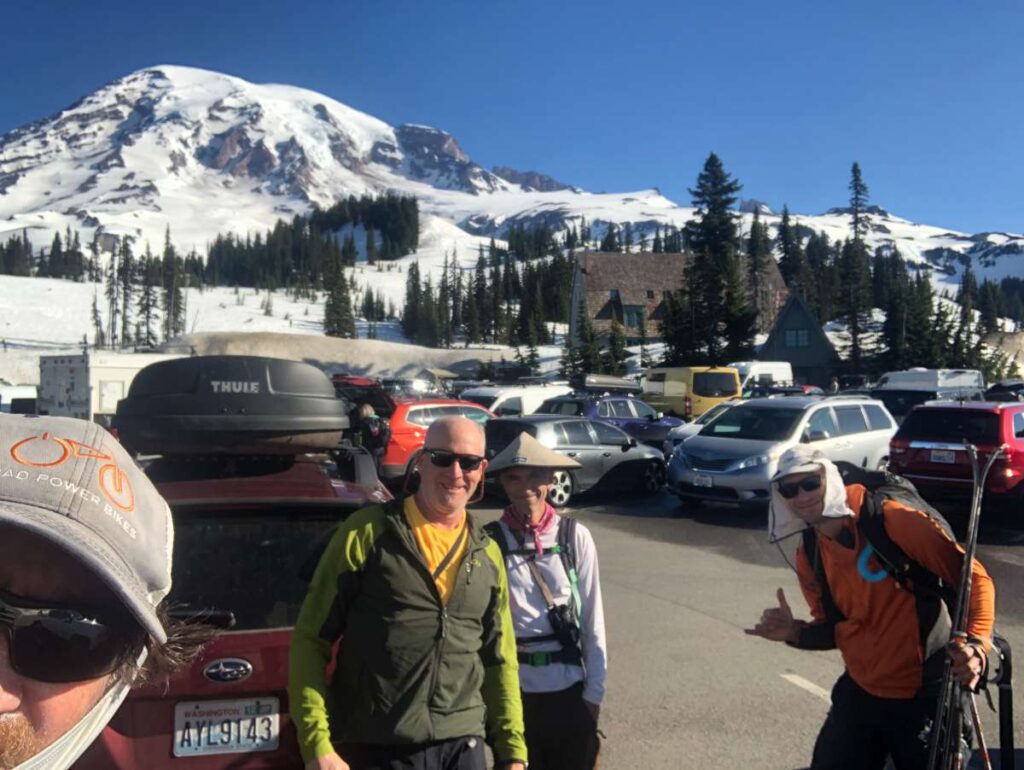
Fifty days of skiing this winter, and I still wanted a long day of ski touring. A big day. The kind you can brag about. It pushes your limits of endurance and skill but you know you can handle it. I wanted something to make all those icy, slushy, miserably cold and wet hours working on edge control, pivot slips and leapers worth it. And I wanted to go someplace beautiful. Not just pretty, but heart-stoppingly beautiful. The kind of beauty that makes your eyes orgasm and your brain hurt.

I opted for a perennial favorite, a tour so popular, that when I mentioned it to my brother-in-law Ryan, he suggested that he could bring his one-year-old son with us. Thankfully my sister stepped in and took the kiddo for a picnic at the beach instead.
We were headed to Camp Muir.
For those who don’t know (and your numbers far outweigh my eye-rolling friends who are only reading this section so they can correct my mistakes) Camp Muir is located at 10,000 feet on the slopes of Mt. Rainier, Washington State’s tallest peak. It’s a popular bivouac for climbers attempting to summit the 14,000’ – sorry, 14,411’ – mountain. But it’s also regularly visited by motivated hikers wanting to experience one of the greatest views in all of the Cascades. From Camp Muir, one can see all of the majestic peaks of the southern cascades: Mt Adams with it’s perfectly symmetrical form, Mt. Hood with it’s wizard-like top, the Goat Rocks Wilderness with their ancient, eroded slopes, and of course, Mt. St. Helens with its crooked caldera and burgeoning crown growing in the midst of a cataclysmic wasteland. And above Camp Muir is the massive, hulking form of Mt. Rainier herself. Tahoma: The Elegant Lady, the greatest of all Cascade peaks with more glaciers, ice fields and cliff bands than one could count in a lifetime.
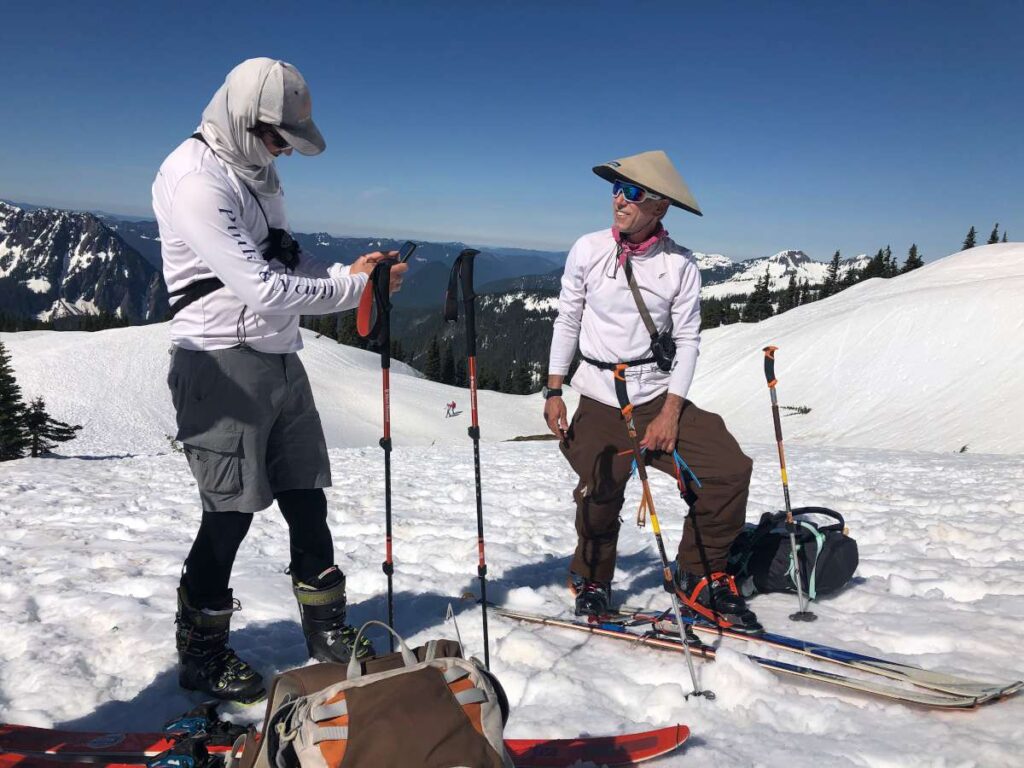
Blessedly, the route to Camp Muir requires minimal technical expertise. Several years ago, Giovannina and I hiked to it using nothing more than a pair of hiking shoes, some Yak Trax (grippy things senior citizens wear to keep from sliding on ice) and a daypack. When we got to the top, I remember sitting and enjoying lunch with a dozen or so backcountry skiers. When their meals were over, they threw on puffies, donned helmets and stepped into their skis for a thrilling ride down almost 5,000 feet of pristine snowfield. We, on the other hand, trundled back down. Since then, I swore I would someday return and ski the Muir Snowfield.
But first I had to learn how to ski.
Over the last several years I’ve become a much more proficient skier. I got a part time job working as a ski instructor at the local ski hill (The Summit at Snoqualmie) where they’ve trained me in proper skiing technique. I took an avalanche safety class to learn how to avoid dying in a cascade of snow and ice. And with the help of some generous friends, the patience of my long-suffering partner and a significant outlay of cash to buy fancy ski gear, I felt like I now had the necessary ingredients to do the trip.
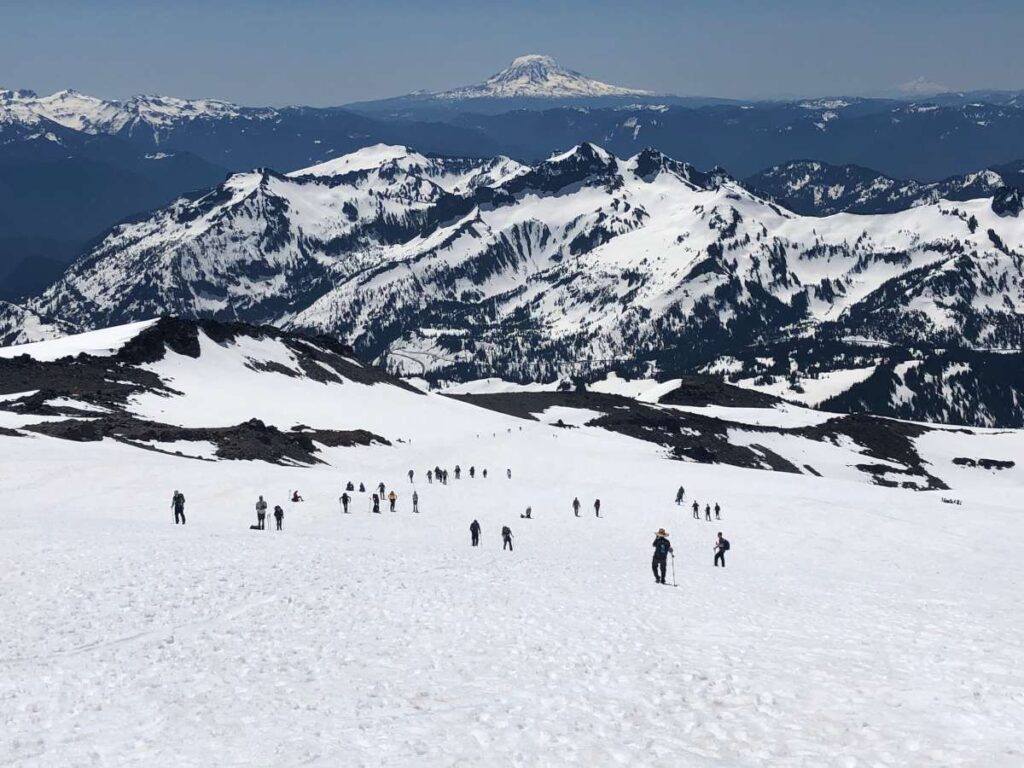
Finding people to join me turned out to be relatively easy. Ryan was onboard before I even asked him. My friend Paul, with whom I’d done several day-trips earlier in the season, was itching to get back out on the snow. My friend James (aka Jamo), had barely skied all season, but was able to secure a hall pass from his wife who had previously led him up Mt. Rainier and knew that a day on the mountain would be good for him.
Whenever planning a backcountry ski tour, weather and avalanche forecasts are always crucial. The weather forecast was calling for clear skies, overnight lows in the 40s and daytime highs near 70F. For those who haven’t traversed a snowfield on such a day, I can tell you that it is far warmer and brighter than you could possibly imagine. The sunlight reflecting off the snow (aka albedo) radiates all around you, causing sunburns in the funniest of places like the inside of your nostrils or the backs of your legs, if you’re wearing shorts. One friend even burned the roof of his mouth while summiting Mt. Rainier. This heat also has a serious effect on the snow, turning the whole mountain into one giant slushy. Thankfully, during the nighttime, the clear skies and radiative cooling freeze the snow. The ideal is to skin uphill while the snow is still firm, but start downhill just as it’s starting to melt. Under the best conditions, you get to ski corn snow, which is soft and forgiving. If we started too late, we’d be skiing on corn snow’s less attractive cousin: slush. Slush has a high water content, which sucks at the bottom of the skis and causes the snow to grab your skis like invisible hand and your knees want to sheer in two. It’s never proved dangerous, but it is uncomfortable.
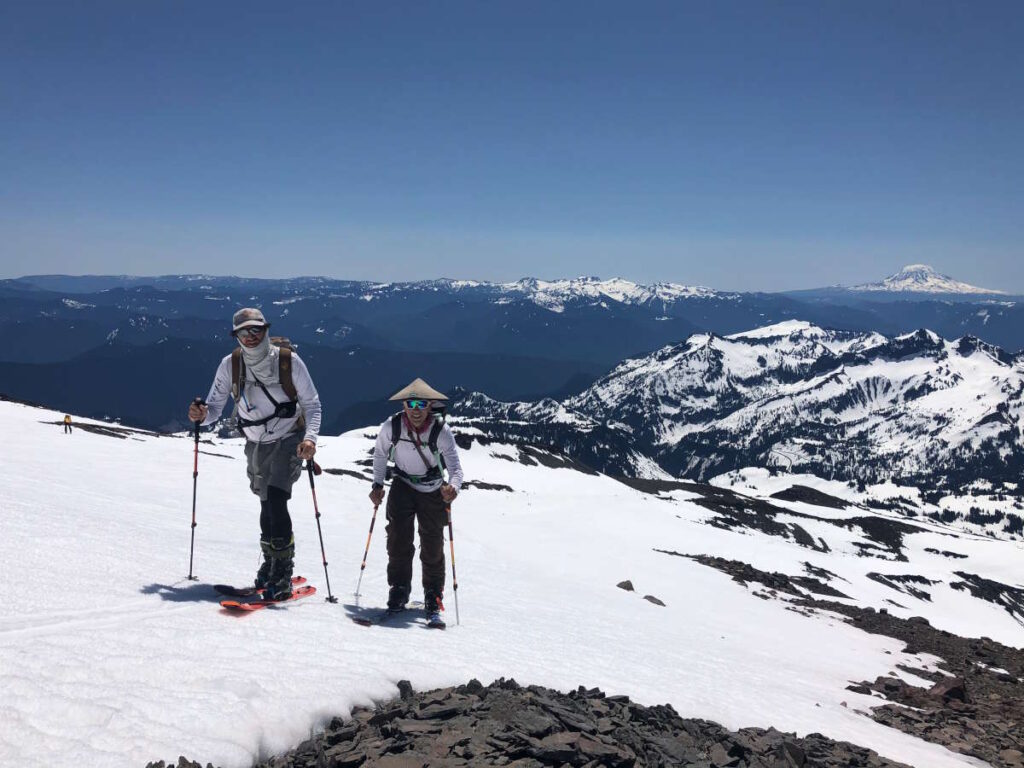
In order to optimize snow conditions, skiers start as early as possible, like before-sunrise-early. I talked with the other guys, and none of us felt all that hardcore so we decided to meet at the park and ride at 5:15, which would get us to the Paradise Parking lot around 7:30 and on the snow by 8 am. Slush be damned – we needed our sleep.
What about the avalanche forecast? One of the reasons people like spring touring – in addition to the ample sunshine – is that all those warm, sunny days cause the snowpack to consolidate into one thick mass. This doesn’t mean that slides aren’t possible, but they are a lot less likely.
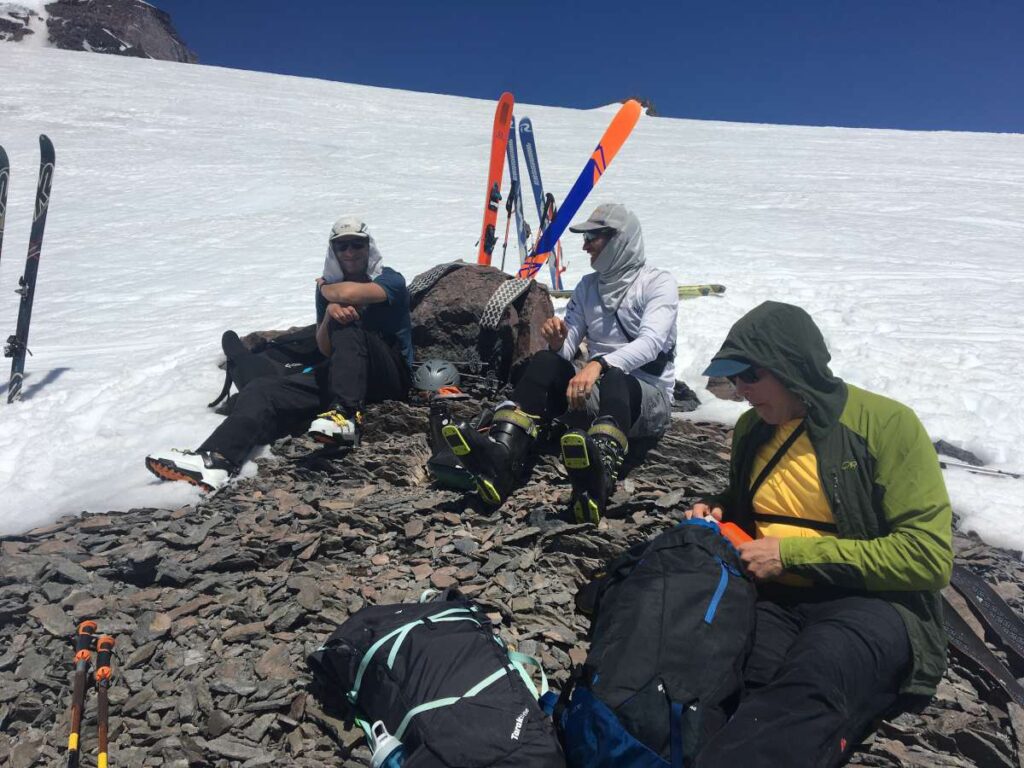
We got to the Paradise parking lot around 7:45, a bit later than we wanted, and by the time we started skinning, there were at least a hundred people making their way towards Camp Muir. About half of these folks were backcountry skiers like us, the other half were hikers, some using microspikes, and some forgoing the extra traction and just using using their boots. We joined the mass of bodies moving up the mountain, falling into a steady pace and enjoying each other’s company on a beautiful Sunday morning.
I was catching up with James when he suddenly stopped in his tracks.
“Uh oh,” he said, bending down to look at his binding.
Noticing that we’d stopped, Paul and Ryan, made their way over to us.
“What is it?” I asked.
“I think I broke a cable.”
Sure enough, one of the cables of James’s telemark bindings had completely broken. The rest of us were using Alpine Touring gear, but Jamo was using a telemark boots and bindings, the original backcountry ski set up. Unlike alpine skiing in which both the toe and heel are attached to the ski, in telemarking, only the toe is attached, and the heal is free to move up and down, like on a cross country ski. This allows an easy motion for moving uphill, but requires special skills to go downhill. Tele turns (as they’re called) look like downhill lunges, the skier having to lead with one leg in front as they make their way down the mountain. When done right, it looks beautiful and all my tele skiing friends love it. But it’s really hard to master, which is one reason why it’s not very popular. Another reason for its lack of popularity is the gear. In addition to special boots that have a bellows built into the toe, the bindings use spring-loaded cables to attach the boots to the ski. It was one of these cables that had broken on Jamo’s ski .
Looking at his busted cable, I had visions of James returning to the car and waiting for us all day as we finished the tour without him. But that wouldn’t be Jamo. Possibly the most resourceful human being I know, James reached into his pack and pulled out a screw driver and some orange, rubber ski straps.

“I’ve got an idea,” he said beginning to unscrew the toe piece of his binding.
Ryan searched through his bag as well.
“I’ve got a real long ski strap,” he said and pulled out an 18” strap from his bag.
Within ten minutes, James had disassembled the binding, attached a couple of these straps and was back skinning uphill. It wasn’t the most secure binding, but it worked.
“Think you’ll be able to ski downhill with that thing?” I asked him.
“Oh sure,” he said waving a hand. “I might end up on my ass, but I’ll make it down.”
We continued upwards, following the trails left by dozens of other skiers and hikers who had chosen snow conditions over sleep. Their paths soon led us to the slopes of Panorama Point, the steepest pitch on our uphill journey. I had brought ski crampons with me, just for this spot, but Ryan said I wouldn’t need them, so I left them in the car. As soon as we got to the steep icy slopes below the Point, Ryan turned to me and apologized. “You’re going to wish you had those crampons,” he said, giving me the look which says “You’re about to have a real learning experience.”
And so I did.
While the others effortlessly navigated the icy slope, I was left to flail and swear my way uphill. Inching upwards, I prayed to the Gods of Snow and Ice that my skins didn’t lose their grip and send me tumbling through the line of folks diligently plodding up the hill behind me. Skinning up a hill like that requires a lot of skill – sort of like barefoot ballet dancing on ice. And while the consequences of messing up wouldn’t be deadly (I hoped,) they would be exhausting and humiliating. Thankfully, my patience and perseverance paid off and I only fell once.
Once atop Panorama Point, I found the guys enjoying a snack and some water while taking in the stunning view. We were in an ocean of mountains. Mostly dark grey peaks and ridge lines, but here and there big, white monsters rose up out of the void, their jagged, snowy visages facing heavenward as if awaiting deliverance. Sweaty and still breathing heavy from my recent efforts, I sipped from my Camelback and chewed on a dry Cliff Bar, my eyes trying to absorb the beauty. I could have stayed all day, but we still had a long way to go. And so we hoisted our packs and continued uphill.
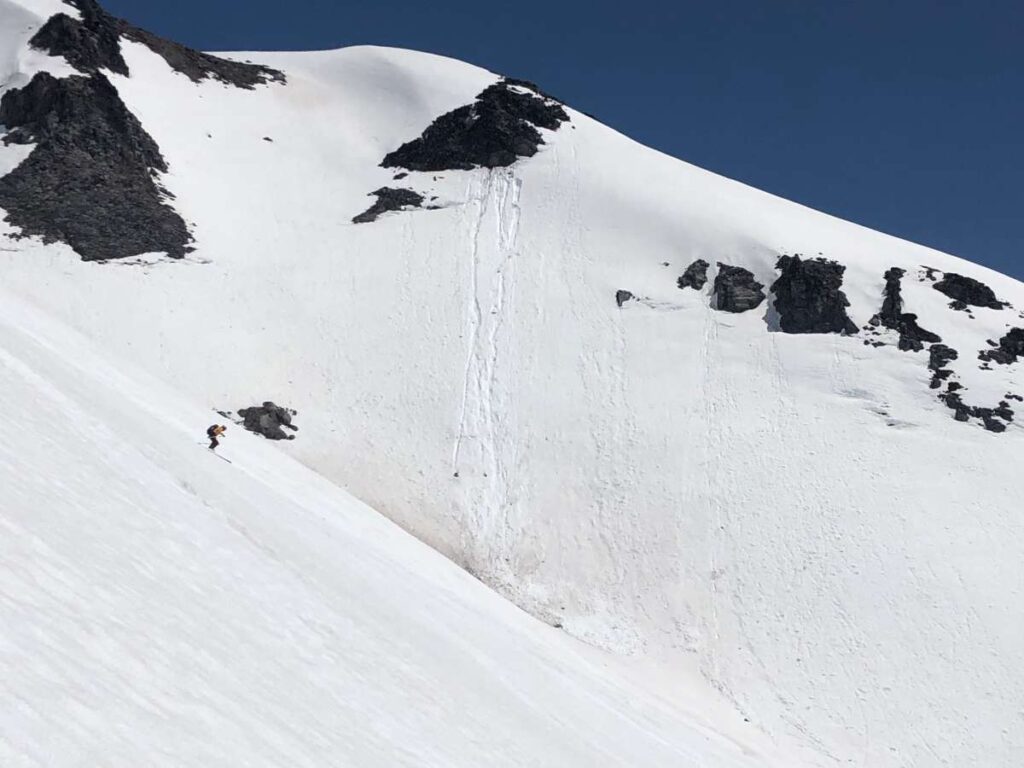
After a brief interlude that involved removing our skis to hike over some dirt and rocks, we finally made it to the Muir Snowfield, that massive, sloped plain stretching for miles upwards towards the flanks of Mt. Rainier. And along the edge of the snowfield stretched a line of travelers, hundreds of them, like ants making their way to a cookie jar. We fell in with the caravan and continued upwards.
The rest of the uphill journey was relatively uneventful. One foot in front of the other. Short strides to conserve energy and dragging toes to maintain the ski’s contact with the snow. It’s sort of like cycling up a big hill. Focusing on breath and form, you find your rhythm and just grind it out. Maybe you talk a bit to the folks around you. But mostly you just plod ahead. Some solo travelers even wore ear buds, as if they were on the treadmill at the gym.
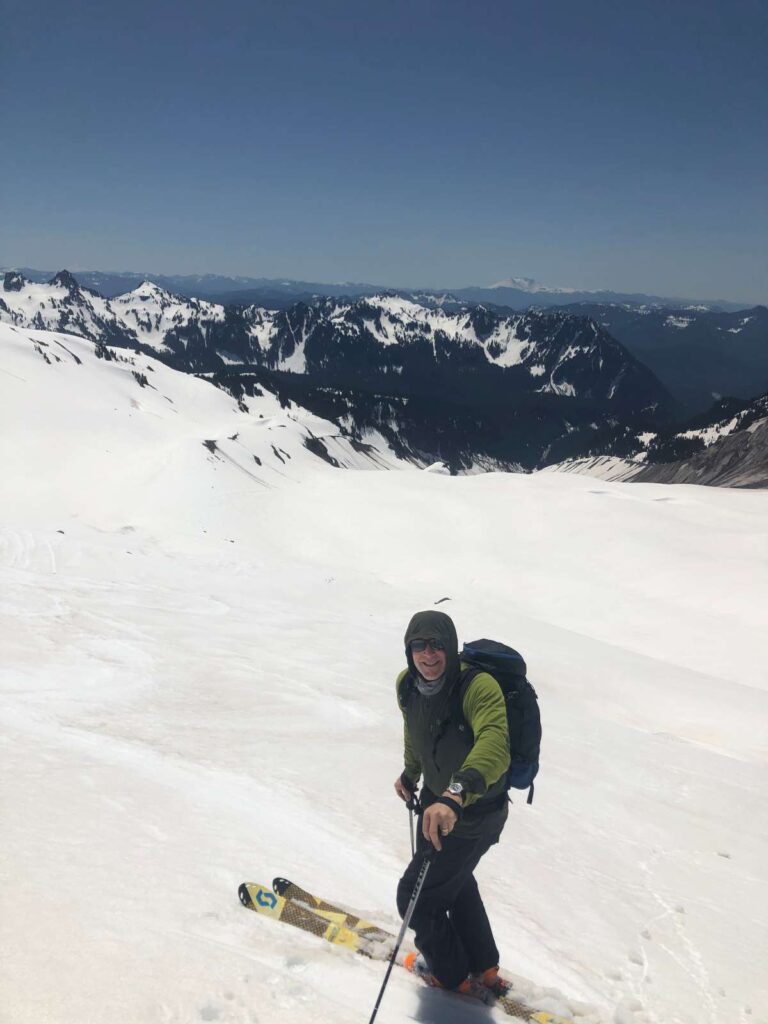
From time to time a few skiers or snowboarders came cruising downhill, wearing the goofy grins that only comes with the spectacular payoff of a massive effort. Invigorated by the slices and carves they made, my spirits rose and I began dreaming of epic ski turns. But looking at the line of people headed towards Camp Muir, the four of us decided to forego Camp Muir and head for the Nisqually Chute, a steeper pitch that would require more skill but would have a bigger payoff. While I had dreamed of skiing The Muir Snowfield, I could now see that the real adventure lay in that steep, narrow chute off to the side. Were we at a ski resort, The Muir Snowfield would be a blue run – fun, but not thrilling. The Nisqually Chute, on the other hand, would be the Double Black Diamond, and leave us with stories to tell.
We traversed across the snowfield to the edge of the chute and stopped for lunch. Skinning uphill uses a whole different set of muscle than downhill skiing. We wanted to give our legs a chance to make the transition, and to fuel ourselves for the downhill run. Donning helmets and switching our boots to ski mode, we locked into our gear and began the slide into the chute. James and Paul opted for the main run, while Ryan and I headed for a slot off of one shoulder. The entrance was a lot steeper than we had anticipated and I felt like I could reach out with my hand and touch the snow while I was standing there.
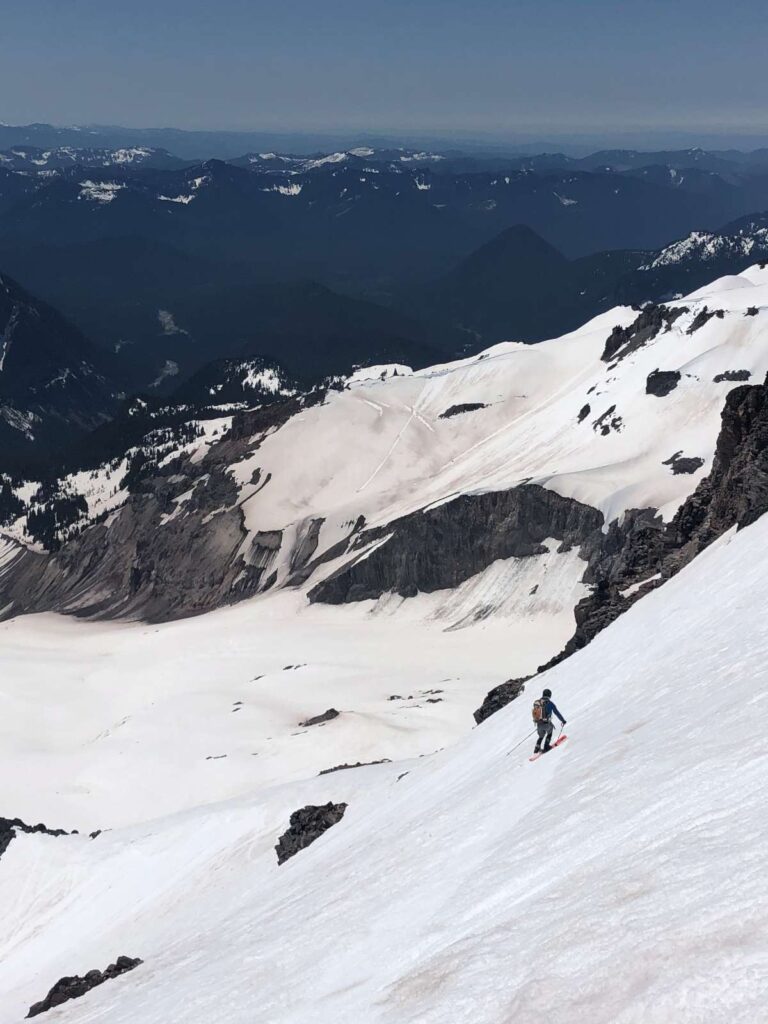
The first downhill turn is always the hardest. Logically, I knew I had skied steeper slopes than this, but there’s a difference between logic and action. Thank god for the side slip. Taking aim at the entrance of the slot, Ryan and I slipped our way down the face of the chute, stopping just above our desired run. The pitch wasn’t as steep here, but it rolled over so you couldn’t see where you were skiing to – the hill just just seemed to vanish in front of us. We had already scoped it out and knew this run was skiable, but it took courage to head downhill without seeing where we were going.
Ryan went first.

Letting out a war whoop as he sliced his way through the soft corn snow, he quickly vanished below the horizon. I waited for his call to let me know it was ok. When it finally came, I gritted my teeth, shifted my weight to my uphill ski and pointed my pole straight down the fall line. Speed ensued.

The first turn happened a lot faster than I expected. Thankfully, the snow was soft and forgiving, otherwise, I would’ve been on my ass. Like Yoda to Luke, the image of Alan Tencer, my ski guru, appeared in my mind and said, “Flex to control your speed.”
So I flexed my knees just as I’d been taught, and the world became awesome.
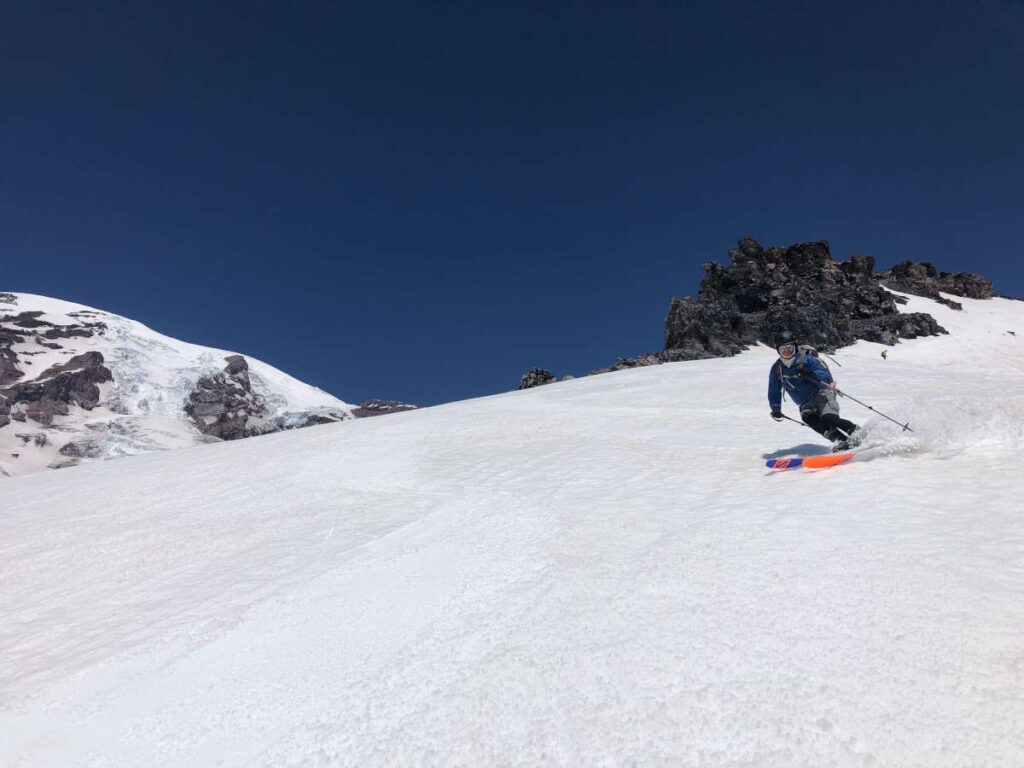
And by awesome, I mean completely sick, tripping-through-your-eyeballs, next-level-orgasmic awesome.
I felt all of those vertical feet that I climbed over the last several hours turn into a blissful vertical drop. The wind hit my face, my mind dissolved into pure energy and my body transmuted until I was merely the faintest breeze gently rolling down a hillside.

The four of us were in heaven. Surrounded by rock, snow and cascading waterfalls, we picked our way down the belly of the valley, absorbing beauty at every turn. By the time we got to Ryan’s car at the parking lot we were simultaneously invigorated and exhausted. Sitting in the sunshine waiting for Ryan and Paul to return with Paul’s car, I asked Jamo how it was skiing downhill with that broken binding.
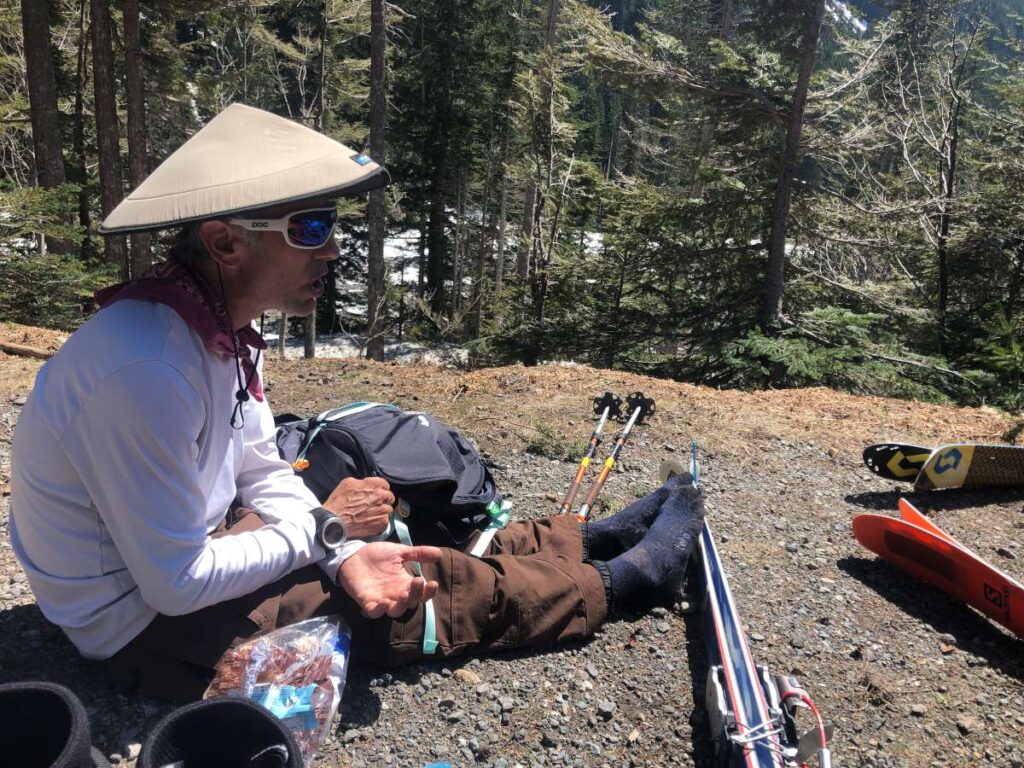
“Ain’t no thing, chicken wing! There were lines everywhere!”
And raising our beers towards the heavens, we drank to the mountains, the snow and the friends crazy enough to share these adventures with.
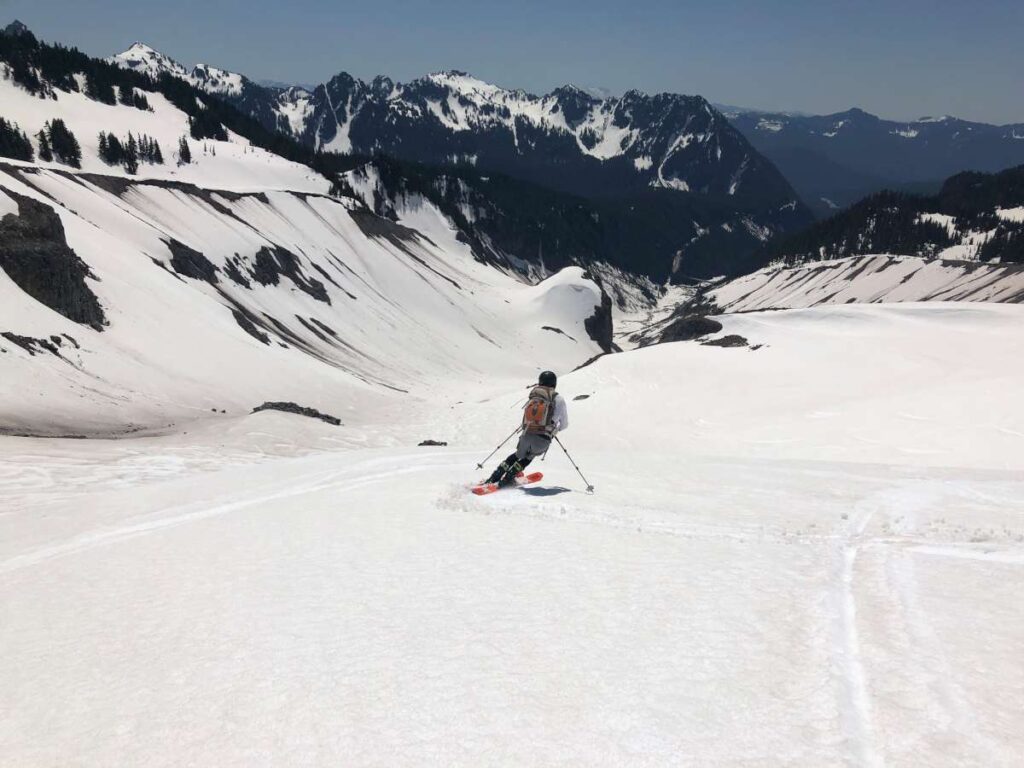
Tim Murphy
Ah – memories. I accompanied some friends climbing Rainier up to Camp Muir in about 1979, I think, intending to ski down. I loafed at the camp just a tiny bit too long and the perfect corn snow crusted over as the temperature dropped. My wooden XC skis with just toe clips did not appear to like my telemarking style and kept wrenching off. I finally ripped a ski off and threw it down hill in disgust – and then realized I had to retrieve it. I hit the Paradise lot as the sun started to set, with a pounding headache, nauseated and generally miserable. The sun was in my eyes as I drove west out of the park, just for good measure. Right past Elbe, I pulled over into a parking area near Lake Alder, threw my sleeping bag in the ditch and slept – waking only at 3AM to the sound of a car door slamming. Drove home to Seattle, feeling much better, to my only slightly worried girlfriend. And imagine – I did all that without one cell phone call!
womoses
I love it! If you’re ever interested in writing about your adventures, please let me know. I’m always looking for contributors. Peace. -Woody